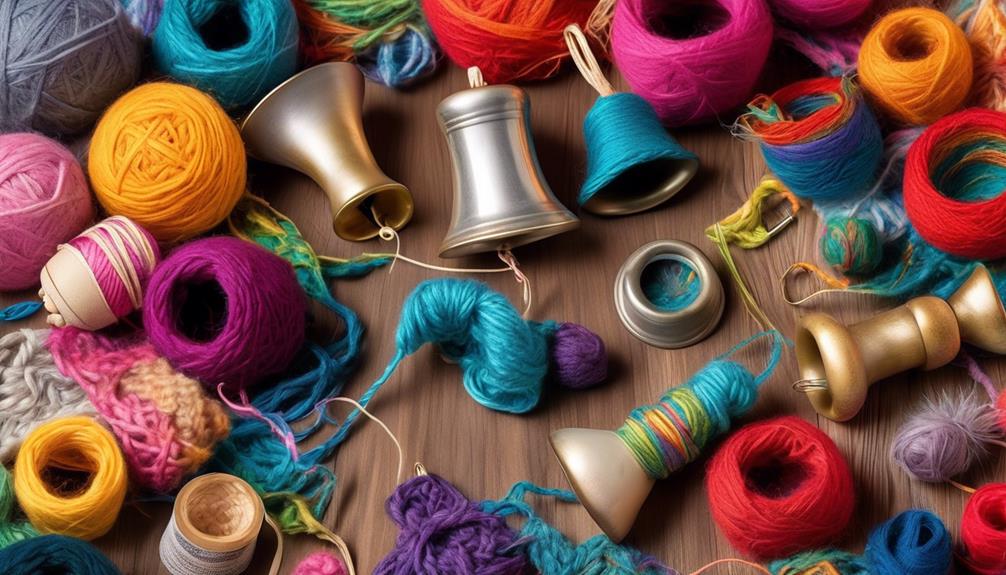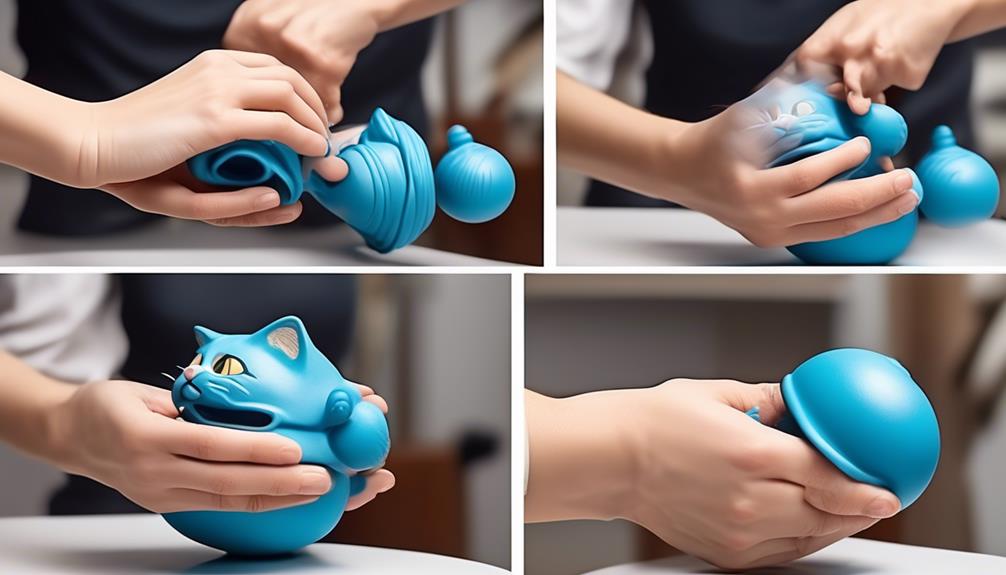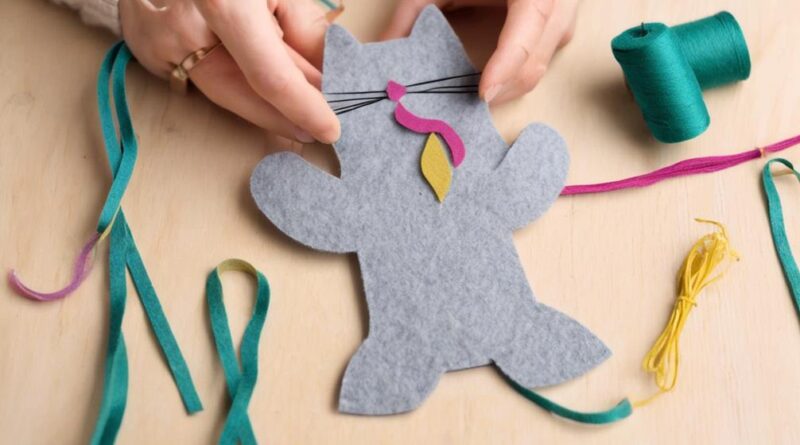How-To Guide: Creating Bell-Filled Cat Toys
When it comes to keeping your feline friend entertained, nothing quite captures their curiosity like a jingling bell. Imagine the joy on your cat's face as they pounce and play with a homemade toy filled with these delightful little sounds.
But creating bell-filled cat toys isn't just about the bells; it's about safety, creativity, and the satisfaction of seeing your pet enjoy something you made with your own hands.
So, how do you ensure that the toys are not only entertaining but also safe for your furry companion? Let's explore the art of crafting bell-filled cat toys and discover the secrets to making them a hit with your cat.
Choosing the Right Bell for Cat Toys

To ensure the best result, select a small, lightweight bell for your cat toys. Cats have sensitive hearing, so a small bell that produces a gentle, melodic sound is ideal. Avoid loud, jarring bells that could startle or irritate your cat. Pay attention to your cat's reaction to the sound of the bell to gauge their preferences. Some cats may prefer a softer jingle, while others might enjoy a slightly more pronounced sound. By observing your cat's response, you can tailor the bell selection to suit their liking, enhancing their playtime engagement.
In addition to the bell sound, the size of the bell also plays a crucial role in your cat's playtime engagement. A lightweight, small-sized bell is easier for your cat to bat around, chase, and catch. It adds an element of excitement to their play and stimulates their hunting instincts. Opt for a bell that's just the right size for your cat to interact with effortlessly. A bell that's too large or heavy may discourage play, while a tiny bell mightn't provide enough auditory and physical stimulation. Finding the perfect balance in the size of the bell can make a significant difference in keeping your feline companion entertained and active during playtime.
Selecting Safe Materials for Cat Toys
When choosing safe materials for your cat toys, consider the bell's composition and its potential impact on your feline friend's well-being. Cats are curious creatures and tend to chew and bat at their toys, so it's crucial to ensure that the materials used are non-toxic and safe for them to interact with.
Here are some key factors to consider when selecting safe materials for your cat toys:
- Toxic materials
- Avoid bells made from toxic materials such as lead or other harmful substances. Opt for bells that are labeled as non-toxic and safe for pets. Look for materials that are certified as pet-safe to provide peace of mind regarding your cat's health and safety.
- Size considerations
- Ensure that the size of the bell is appropriate for your cat. Bells that are too small pose a choking hazard, while those that are too large may be difficult for your cat to play with. Choose a bell size that's suitable for your cat's breed and size, keeping in mind that it should be large enough to avoid accidental ingestion.
Step-by-Step Guide to Assembling Bell-Filled Toys
You can assemble bell-filled cat toys by gathering the necessary materials and following these simple steps.
Start by selecting the appropriate bell size for your cat toy. Small jingle bells, about 0.5 inches in diameter, work well for most toys. Next, choose the color options for the fabric or yarn that will encase the bells. Bright, contrasting colors often capture a cat's attention best.
To begin assembling the toy, cut a piece of fabric or yarn to your desired length, ensuring there's enough to encase the bells and tie off the ends securely. Then, thread the bells onto the fabric or yarn. If you're using fabric, you can create a small pouch by folding it in half and sewing the edges, leaving enough space for the bells to jingle. For yarn, simply tie a knot at one end, string the bells, and tie another knot at the other end to secure them in place.
Once the bells are enclosed, tie off the ends of the fabric or yarn tightly to prevent the bells from falling out. Trim any excess material, making sure the knots are secure.
You now have a simple, yet entertaining, bell-filled cat toy ready to delight your feline friend. Remember to always supervise your cat when they're playing with toys to ensure their safety.
Incorporating Catnip Into Bell-Filled Toys
Incorporating catnip into bell-filled toys enriches the sensory experience for your feline companion, adding an enticing element to their playtime. Cats are naturally drawn to catnip due to its benefits, and incorporating it into their toys can enhance their play preferences in the following ways:
- Stimulates Playfulness: Catnip can trigger a burst of energy and playfulness in cats, making their playtime with bell-filled toys more engaging and exciting.
- *Catnip-induced Play Behaviors*: Cats may exhibit behaviors such as pouncing, rolling, and batting at toys when they're infused with catnip, providing mental and physical stimulation.
- Relieves Stress and Anxiety: Catnip has a calming effect on some cats, which can help alleviate stress and anxiety during playtime, creating a more relaxed and enjoyable experience.
- *Promotes Relaxation*: Some cats may display a sense of calm and contentment when exposed to catnip, making their play sessions with bell-filled toys a soothing and stress-relieving activity.
Tips for Ensuring Bell Security in Cat Toys
To ensure the security of bells in cat toys, consider using strong, durable stitching to firmly attach them to the toy's fabric. Bell attachment is crucial to prevent the bells from becoming loose and posing a choking hazard to your feline friend. When sewing the bells onto the toy, make sure to double stitch the attachment for added security. This will help to enhance the toy's durability and ensure that the bells stay in place during rough play.
Another tip for ensuring bell security in cat toys is to opt for reinforced seams and high-quality fabrics. When creating the toys, pay attention to the material used and the strength of the seams. Reinforced seams can prevent the bells from coming loose, especially if your cat is particularly enthusiastic during playtime. Additionally, choosing durable fabrics can contribute to the overall sturdiness of the toy, reducing the likelihood of the bells detaching.
Regularly inspect the toys for any signs of wear and tear. Even with the most secure attachments, it's important to check the toys periodically for any loose parts, including the bells. If you notice any damage or loosening, make the necessary repairs promptly to maintain the toy's integrity and ensure your cat's safety.
Decorating Bell-Filled Toys for Cats
How can bells be creatively incorporated into cat toys to enhance their visual appeal and interactive value? When decorating bell-filled toys for cats, consider the placement of the bells and the color options to make the toys more engaging and attractive for your feline friends.
- Bell Placement
- Dangle Them: Attach bells to the ends of strings or ribbons on the toy to create dangling elements that will capture your cat's attention as they play.
- Integrate Them: Sew or attach bells directly onto the body of the toy, ensuring they're securely fastened to withstand your cat's enthusiastic pouncing and batting.
- Color Options
- Contrasting Colors: Choose bell colors that contrast with the toy to make them stand out and catch your cat's eye during playtime.
- Matching Colors: Alternatively, select bell colors that complement the overall color scheme of the toy for a cohesive and visually appealing look.
Testing and Quality Assurance for Bell-Filled Toys

Consider the next step in ensuring the appeal and durability of bell-filled toys for your feline companions by discussing the testing and quality assurance processes involved.
Bell durability is crucial to the longevity and safety of the toys. To ensure this, quality assurance involves rigorous testing of the bells used in the toys. Manufacturers subject the bells to various stress tests to evaluate their durability. This includes examining the bells for any signs of weakness or damage after being dropped from different heights and exposed to repetitive impacts.
Sound testing is another essential aspect of quality assurance for bell-filled toys. It's important to ensure that the bells produce a pleasant and distinct sound that will capture your cat's attention. Sound testing involves checking the consistency and clarity of the bell's jingle to guarantee that it will pique your cat's interest and provide auditory stimulation.
By subjecting the toys to sound testing, manufacturers can ensure that the bells will produce an enticing sound that will engage your cat's senses.
Packaging and Presenting Bell-Filled Cat Toys
Ensuring the visual appeal and safety of bell-filled cat toys begins with thoughtfully designing their packaging to attract both felines and their owners. Creative packaging plays a crucial role in catching the eye of potential customers and standing out on the shelves.
Here are some tips for packaging and presenting bell-filled cat toys:
- Design:
- Consider using vibrant colors and playful designs to attract both cats and their owners. Cats are drawn to bright colors, while owners are more likely to pick up a product that looks fun and engaging.
- Safety Features:
- Ensure that the packaging is secure and tamper-proof, especially if the toys have small bells or other components that could be a choking hazard for cats. Safety should be a top priority when designing the packaging.
When creating the packaging for bell-filled cat toys, keep in mind that it shouldn't only be visually appealing but also informative. Include key information such as the benefits of the toy, materials used, and any safety precautions. Additionally, consider using clear windows or openings in the packaging that allow customers to see and hear the bells inside, further attracting them to the product.
Frequently Asked Questions
Can I Use Different Types of Bells for Cat Toys, or Do I Have to Use a Specific Kind?
You can use different types of bells for cat toys, but ensure they're safe for your pet. Always consider the size and weight of the bell to prevent any choking hazards.
Check the bells regularly for wear and tear, and replace them as needed. Avoid using essential oils as alternatives to bells, as they can be toxic to cats.
Prioritize your cat's safety when choosing and using different bell types for their toys.
How Often Should I Replace the Bells in My Cat's Toys?
You should replace the bells in your cat's toys every few months to ensure they remain safe and effective.
Different bell types can affect how long they last, so keep an eye on their condition. If you notice any damage or wear, it's best to replace them sooner.
Regularly checking and replacing the bells will keep your cat's toys enjoyable and safe for playtime.
Are There Any Specific Safety Guidelines I Should Follow When Using Different Materials to Make Cat Toys?
When making cat toys, safety precautions are crucial. Consider the materials' durability, potential choking hazards, and toxicity.
Perform a risk assessment for each toy's construction, ensuring it poses no harm to your feline friend. Opt for sturdy, non-toxic materials and avoid small parts that could be ingested.
Prioritize your cat's safety by meticulously selecting materials and constructing toys with care.
Can I Use Essential Oils or Other Scents Instead of Catnip in Bell-Filled Toys?
Yes, you can use scented oils in bell-filled cat toys. However, it's important to consider safety guidelines. Certain scents can be harmful to cats, so make sure to research pet-safe essential oils. Always prioritize your cat's safety when choosing scents for their toys.
Additionally, be cautious of using scents that may overwhelm or irritate your cat's sensitive sense of smell. Cats rely heavily on their sense of smell, so it's important to choose scents that they find pleasant and not overwhelming.
Always monitor your cat's reaction to scented toys to ensure they're enjoying them safely. If you notice any signs of discomfort or irritation, it's best to remove the scented toy and consult with your veterinarian. Your cat's well-being should always be the top priority when introducing any new scents or toys into their environment.
How Can I Make Sure That the Bells Are Securely Attached to the Toys and Won't Come Loose During Play?
To secure the bells and ensure toy durability, use strong and durable materials like heavy-duty thread or fishing line when attaching the bells.
Double knot or use a secure stitch to fasten the bells to the toy securely.
Test the attachment by giving the toy a gentle tug. If the bells feel loose, reinforce the attachment with additional stitches.
Regularly check the toys for any signs of wear and tear to prevent any potential hazards during play.
Conclusion
Now that you have learned how to create bell-filled cat toys, you can provide your feline friends with hours of entertainment and stimulation.
By following the steps outlined in this guide, you can ensure that the toys are safe and secure for your pets to play with.
Get creative with your designs and packaging to make your bell-filled cat toys even more appealing to your furry companions.
Enjoy crafting and watching your cats enjoy their new toys!
